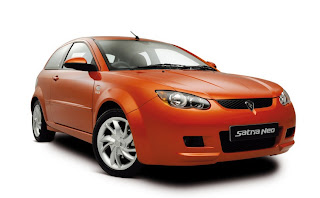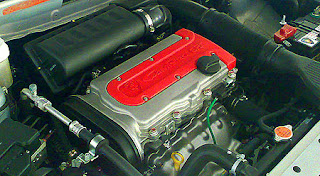The CamPro engine is the first automotive engine developed together with Lotus by the Malaysian carmaker, Proton. The name CamPro is short for Cam Profiling. This engine powers the Proton Gen-2, Proton Satria Neo, Proton Waja Campro, Proton Persona, Proton Saga and Proton Exora. The CamPro engine was created to show Proton's ability to make its own engines that produce good power output and meet newer emission standards. The engine prototype was first unveiled on October 6th 2000 at the Lotus factory in UK before it debuted in the 2004 Proton Gen•2.
All CamPro engines incorporate drive-by-wire technology (specifically electronic throttle control) for better response, eliminating the need for friction-generating mechanical linkages and cables.
CamPro Technical Specifications
Basic DOHC engine
The basic CamPro engine is used in older Gen•2 models and coded as S4PH. It is a DOHC 16-valve 1.6-litre engine that produces 110 bhp (82 kW) @ 6,000 rpm of power and 148 N·m (109 ft·lbf) of torque. This is the engine that powers the Proton Gen•2. The S4PH engine can be fitted with Cam Profile Switching (CPS) and Variable Inlet Manifold (VIM) technology.
Besides this 1.6-litre engine, Proton has produced the 1.3-litre version of the CamPro engine. Even though the S4PH engine seems to be quite powerful at higher revs, its performance is reportedly sluggish at lower revs. This is proven by driving the Gen•2 uphill, where drivers who drive the manual transmission version have to periodically shift between 2nd gear and 3rd gear. This is due to its torque dip in the crucial 2,000 - 3,000rpm range where the torque actually decreases before picking up back to the maximum torque at 4,000rpm. This torque characteristic can be clearly seen in manufacturer published engine performance curves.
Another engine option for the basic DOHC engine is a 1.3-litre engine coded as S4PE. The S4PE engine produces 94bhp (70kW) @ 6,000rpm and the torque of 120 N·m (89 ft·lbf) @ 4,000rpm, which is more powerful than the other 1.3-litre rivals, even variable valve timing technology, it also (like its bigger brother)
displays a torque dip at typical engine speeds of 2,000-3,000rpm.
The bore x stroke dimensions for both engines are as follows:-
S4PH (1.6L): 76 x 88 mm, resulting the displacement of 1598 cc.
S4PE (1.3L): 76 x 73.4 mm, resulting the displacement of 1332 cc.
Applications:
2004 - 2008 Proton Gen-2
2006 - 2008 Proton Waja
2006 - present Proton Satria Neo (Lite & M-Line)
2007 - 2008 Proton Persona
CamPro CPS and VIM engine
The CamPro CPS engine uses a variable valve lift system (Cam Profile Switching system) and a variable length intake manifold (VIM; not to be confused with the stand-alone IAFM used in the 2008 Proton Saga) to boost maximum power and improve the CPS engine's torque curve over the standard DOHC CamPro engine. The engine's Variable-length Intake Manifold (VIM) switches between a long intake manifold at low engine speeds and a short intake manifold at higher engine speeds. Proton cars use a longer intake manifold to achieve slower air flow; as it was found that promotes better mixing with fuel. The short intake manifold allows more air in faster. This is beneficial at high RPMs.
The Cam Profile Switching (CPS) system uses a trilobite camshaft to switch between two different cam profiles. One cam profile provides low valve lift, while the other cam profile has a high valve lift. The low valve lift cam profile is used at low to mid engine speeds to maintain idling quality and reduce emissions, while the high lift cam profile is used when the engine is spinning at mid to high engine speeds improve peak horsepower and torque.
Unlike the other similar variable valve timing systems such as the Honda VTEC, the Toyota VVT-i and the Mitsubishi MIVEC which use rocker arm locking pins to change the valve timing, the CPS system uses direct-acting tappets with locking pins to change the valve timing and lift profile.
VIM switches from the long to short runner at 4,800rpm, while the CPS system switches over at 3,800rpm (4,400rpm in the Proton Satria Neo CPS).
The result is 125 bhp (93 kW; 127 PS) at 6,500rpm and 150 N·m (110 ft·lbf) of torque at 4,500rpm compared to the non-CPS CamPro’s 110 bhp (82 kW; 112 PS) at 6,000rpm
and 148 N·m (109 ft·lbf) of torque at 4,000rpm. Proton claims that there is better response and torque at low engine speeds of between 2000 - 2500rpm.
The new CPS engine first made its debut in the face-lifted Proton Gen•2 launched in Thailand in 2008, and made its first Malaysian debut in the Proton Waja CamPro 1.6 Premium (CPS).
Applications:
2008 Proton Gen-2 (H-line)
2008 Proton Waja
2009 Proton Satria Neo (H-Line)
2009 Proton Exora
2010 Proton Gen-2 Facelift (M-Line)
CamPro IAFM engine
The CamPro IAFM (Intake Air-Fuel Module) is essentially a basic DOHC CamPro engine equipped with a variable-length intake manifold, developed under a joint fast track programme that began in April 2005 by EPMB, Bosch and Proton. However, the IAFM differs from the VIM (Variable Inlet Manifold) for the CamPro CPS engine in terms as follows:
The IAFM is a stand-alone module that can be fitted with a basic DOHC CamPro engine whereas the VIM needs to work in conjunction with the CPS system in a CamPro CPS engine. The IAFM is operated by the engine vacuum, while the VIM uses an ECU-controlled solenoid. The Intake Air-Fuel Module for the Proton's CamPro engine debuted in the second-generation Proton Saga, which was launched on 18 January 2008. It was first made known to the public in October 2006, when it was still in its advanced tooling stages.
With the IAFM, the 1.3L engine used in the Proton Saga now produces 98 bhp (73 kW) @ 6,500rpm. The maximum torque is slightly reduced to 113.2 N·m (83.5 ft·lbf); however, the engine has broader torque range and the noticeable torque dip in the basic DOHC CamPro engine has been eliminated. The official brochure is only published with the familiar 94 bhp (70 kW) @ 6,000rpm power and 120 Nm @ 4,000rpm torque for consistency with other 1.3-litre Proton models.
Meanwhile, the output of the 1.6-litre version of the IAFM engine which debuted in the 2008 Proton Gen-2 M-Line produces 110 bhp (82 kW) @ 6,500rpm of power and 148 N·m (109 ft·lbf) of torque, and the torque dip around 2,500-3,500rpm has been eliminated.
Applications:
2008 Proton Saga
2008 Proton Gen-2 (M-line)
2008 Proton Persona (Elegance)
Hybrid CamPro engine
In March 2007, Proton and Lotus have announced their concept model of a Proton Gen-2 powered by a hybrid powerplant that uses the CamPro engine. The concept model was revealed during the 2007 Geneva Motor Show from 8 ~ 18 March 2007.
The hybrid power-plant system, which is known as EVE system (Efficient, Viable, Environmental) will be using the same S4PH engine as the one that powers the present gasoline version of the Gen•2, combined together with a 30 kW, 144V electric motor. The main purpose of the hybrid power plant system is to provide a hybrid system that can be retrofitted to existing models, retaining the same power-plant and also eliminating the need to develop a completely different platform, like the Honda Civic Hybrid. Unlike the IMA (Integrated Motor Assist) technology in the Civic Hybrid that uses a bulky Ni-MH battery pack, the EVE Hybrid system will use a Li-ion battery pack inside the engine bay.
The EVE Hybrid System will have 3 key technologies:
- "Micro-hybrid" start-stop system - An integrated starter-alternator system is installed to switch off the engine automatically when the engine stops, for example at a traffic light. The engine will automatically restart when the gas pedal is depressed.
- Full parallel hybrid technology - Combines the existing S4PH engine with a 30 kW, 144V electric motor, resulting in higher power (141 bhp combined), higher torque (233 N-m combined), lower emission (up to 22% carbon dioxide reduction) and better fuel economy (up to 4.6 L/100 km). The system also includes regenerative braking system.
- Continuously Variable Transmission (CVT) - The CVT system provides an infinite number of gear ratios for better efficiency.
The combined power and torque for the power-plant system are as follows:
Max power (gasoline engine only): 110 bhp (82 kW; 112 PS) @ 6,000rpm
Max torque (gasoline engine only): 148 N·m (109 ft·lbf) @ 4,000rpm
Max power (combined): 141 bhp (105 kW; 143 PS) @ 5,500rpm
Max torque (combined): 233 N·m (172 ft·lbf) @ 1,500rpm (limited to 180 Nm continuous)
Proton will start commercialising their upcoming hybrid vehicles equipped with the EVE Hybrid System within 2011-2012.
CamPro CFE engine
The CamPro CFE engine is the light-pressure intercooled turbocharged version of the 1.6-litre CamPro engine, with the maximum boost pressure of 0.75 bar (75 kPa; 10.9 psi). The CFE is the acronym of "Charged Fuel Efficiency".
The idea of the production was first revealed by Proton Managing Director Datuk Syed Zainal Abidin on December 13th 2008, due to the new market trend of having small displacement engine but forced-aspirated to produce the power output equivalent to a larger motor, a similar concept as the Volkswagen TSI twincharger technology and the Ford EcoBoost engine. The finalized engine was first debuted during the KLIMS 2010.
The engine is capable to produce 138 bhp (103 kW; 140 PS) @ 5,000 rpm of power and 205 N·m (151 ft·lbf) @ 2,000-4,000 rpm of torque. To accommodate the increase of engine power, several changes to the technical specification have been done. While the engine bore remains at 76 mm, the stroke is shortened to 86 mm compared with 88 mm as in other 1.6L CamPro engine variants, resulting the engine displacement of 1561 cc. The compression ratio is reduced to 8.9:1 from the previous 10:1.
A variable valve timing mechanism is also added for the intake valves, but it alters the cam phasing and valve opening timing continuously rather than altering the valve lift at a preset engine speed as in the CPS mechanism.
Applications:
2012 Proton Exora Bold
2012 Proton Preve
Future plans
Currently, Proton is planning to develop a new engine known as the code name "Family Y engine" with option of displacement between 1.2l, 1.5l, and 1.8l all in
the variant of either natural aspirated or in force induction type. The existing CamPro engines which are limited to 1.3-litre and 1.6-litre engine options only will be EOL (End of Life) soon after. In addition, Proton is also planning to produce the diesel version of the CamPro engines.









Looking forward to knowing more engines of Proton Saga.
ReplyDeleteProton's CAMPRO engine is a DOHC powertrain designed for performance and efficiency, producing around hp and ge proton Nm torque. It features Variable Valve Timing in newer models for better fuel economy and power delivery.
ReplyDeleteThe muscle tone and head size on these pitbull puppies for sale are unmatched.
ReplyDelete